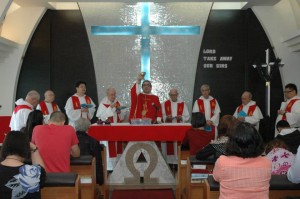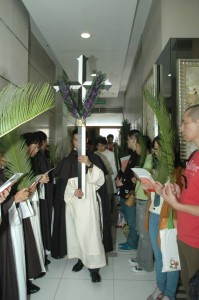Today is Palm Sunday. It is the beginning of the end of a man, whom for many of his followers did not see him as what He claimed to be, the Son of God. However for us, today is the beginning of the time when we welcome Jesus into Jerusalem and support him in his last days until we meet him again after the resurrection.
The royal entry of Jesus into Jerusalem is not just an event that took place by chance. Jesus knew well what He was doing, and for sure He thought of every step before he headed for Jerusalem. Jesus’ entry into the city of Jerusalem was not his first time, but it was a time that echoes many details from the life of the ancient kings of Israel and contemporary history.
The four canonical Gospels portray several aspects about Jesus’ triumphal entry into Jerusalem, which I would like to share with you so as to better understand the real meaning of this event, and also the welcome and rejection of the people who saw him coming into Jerusalem.
If we go over the different narratives of Jesus’ entry into Jerusalem, we will be able to see a very simple fact in all of them: the Jews were angered and offended by the trouble that Jesus had created with his trip to Jerusalem. And they were right to have this kind of sentiment because Jesus’ triumphal entry took place during one of the most important festivals in the Jewish calendar, the Passover. And as we all know at the Passover the Jews commemorate their liberation from slavery and the exodus of the Israelites from Egypt, which took place 3000 years before Christ.
As we continue reading the narrative event, we will see Jesus coming through the main gate of Jerusalem and people at both sides welcoming him with palm branches. This was an insult not only to the Jews and to the High Priests but also to the Romans, and again they had the right to have this kind of sentiment, since the welcoming with palm branches was a symbol of triumph and victory in the Greco-Roman culture of the Roman Empire, and was the most common attribute of the goddess.
Another symbolism that Jesus used when he entered Jerusalem was that of Jesus riding a donkey. Once again the religious authorities, and the Romans felt offended and angered, and again they had the right to have this kind of sentiment. This symbolism referred to the Eastern tradition that a donkey is an animal of peace, versus the horse, which is the animal of war. A king rode upon a horse when he was sent on war and rode upon a donkey when he wanted to point out he was coming in peace.
Jesus entry into Jerusalem had a very powerful message for the people of his time and for all of us. It symbolized a triumphal entry but not as a war king but as the Prince of Peace, which in some way was contrary to the thinking that the people of his time had about the Messiah. This humble but powerful act makes Jesus being recognized by some and rejected by others.
Jesus is recognized as the Son of God by those who at the gates of Jerusalem, in humility are full of the hope that redemption would come. They cry “Hosanna†and lift up the palm branches and cast their poor garments of little worth on the grounds before Jesus as they recognize the one who comes in the name of the Lord.
Jesus’ public life messages, his miracles and now his entry into Jerusalem like a king of peace is what made others reject him crying out not “Hosanna†but “Barabbas†and later “Crucify himâ€. They were the people who saw Jesus blocking their passage in and out of Jerusalem and wanted to put him out of their way. They were the people who would only accept Jesus if he is the Messiah that they wanted.
My dear brothers and sister, like the people in the crowd waiting for Jesus to enter Jerusalem, it is easy for us to be part of the crowd and cry out “Hosanna†and it is easy for us also to shout even louder “Barabbas†and later on “Crucify him.†It is easy for us to be part of the crowd to look from a distance at Jesus carrying the cross. It is easy for us to be part of the crowd that follows Jesus to Calvary and see his crucifixion, and go back home sad and disappointed.
In our daily life, it is easy to be part of the crowd and confess ourselves disciples of Jesus; to shout aloud that we love each other, but we are never there when our brothers and sisters need us most. It is easy to hide ourselves in the crowd and never take the first step to forgive. The crowd is afraid of proclaiming Jesus’ message and so we are. The crowd abandons Jesus because he is not the God they want and so too we hide ourselves in the crowd and become one of them, because sometime we want another God, because He is blocking our way in and out of our own life.
As it does every year, today the Church invites us to reflect upon the sequence of events in the life of Jesus – beginning with his triumphal entry into Jerusalem, which we commemorate today, through the events of the Last Supper, his agony in the Garden of Gethsemane and betrayal to his crucifixion and death. But we have to reflect not so much about how much Jesus suffered, but rather about how much He loved. Let us not be naive and think that pain and suffering for the sake of suffering is redemptive. Contrary to what many people believe, suffering is not necessarily redemptive. What makes the pain and suffering of Jesus redemptive is the fact that it resulted from his extraordinary love for us.
Let us remember the words of Alice Cary: “True worth is in being, not seeming: in doing, each day that goes by some good.” During this Holy Week let us wrap ourselves not with sorrow and suffering but with love and forgiveness. With the new spirit of having been saved, let us show our gratitude, even in the mist of our own physical or spiritual suffering, by helping others to know God and getting sinners to return to God.
Fr. Alejandro Salcedo, OP
St. Dominic’s Priory
March 29, 2015


